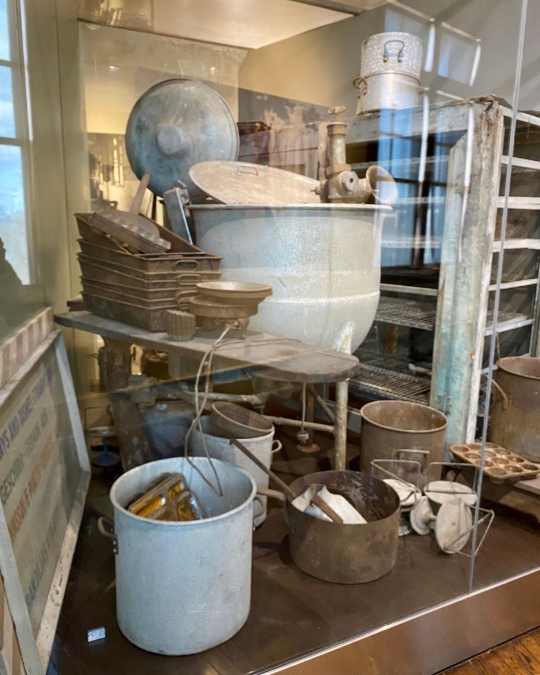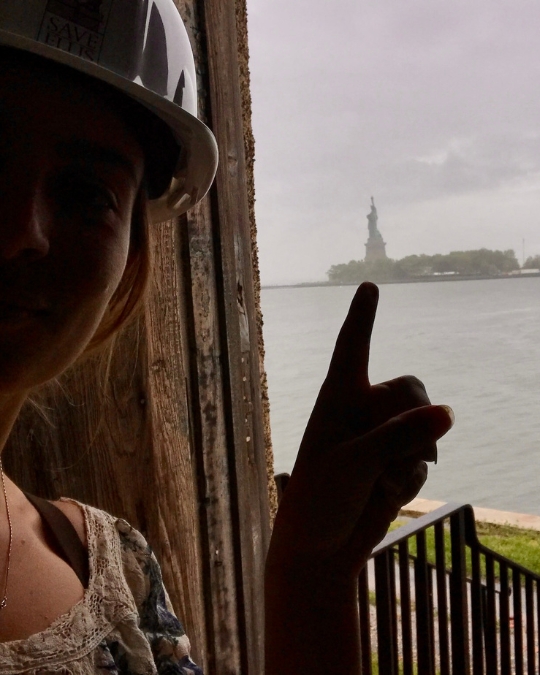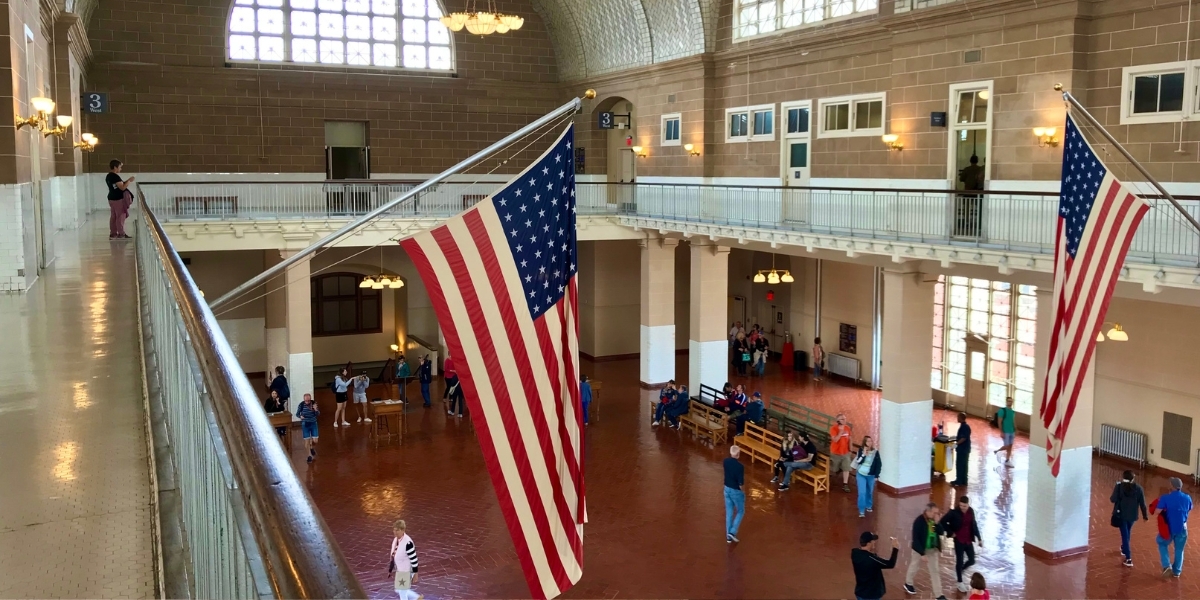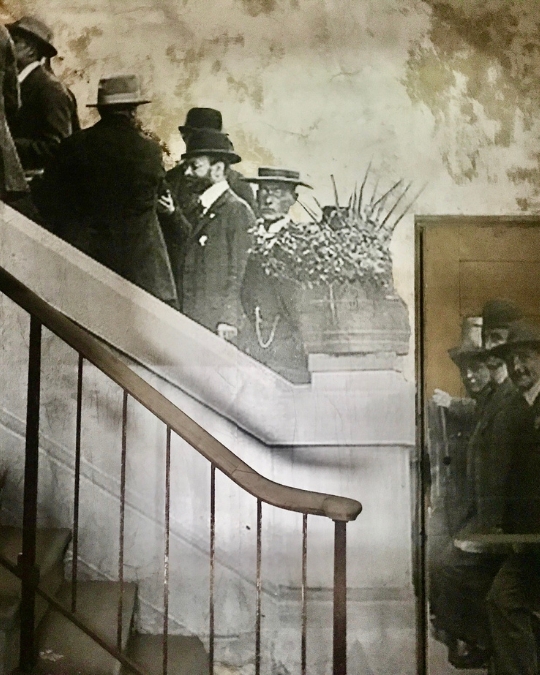Main Menu
-
ALL TOURS & ACTIVITIES
-
ALL TOURS & ACTIVITIES
- Cruises & Helicopters
- Museum Tickets + NYC Passes
- Broadway Shows
- NYC by Night: Cruises & Activities
- NYC by Holidays: Cruises & Activities
- Restaurants
- Top Sellers
-
ALL TOURS & ACTIVITIES
- Offers & Holidays
- Transfers
- NYC Guide
- Stay
- Travel Planner™
- Disney™
Ellis Island and the Immigration Museum
Discover the island's history, ferry tickets, tour options. Categories: What to see - Museums
WHERE: New York BayOPENING HOURS: 9:30 am– 4:00 pm
ACTIVITY: Sightseeing
Page Index – Ellis Island and the Immigration Museum


- - Ellis Island and the Immigration Museum: How to Visit One of New York's Most Moving Landmarks
- - Ellis Island: Where the Story of the U.S. Began
- - How to Visit Ellis Island: Hours, Ferries & Tickets
- - ELLIS ISLAND - UNFRAMED BY JR
- - The History of Immigration at Ellis Island
- - ELLIS ISLAND - MUSEO DELL'IMMIGRAZIONE
- - The Ellis Island Immigration Museum: What to See and How to Visit
- - Why Visit Ellis Island with a Private Tour
- - Map and Video Immigration Hub & Museum
Ellis Island and the Immigration Museum: How to Visit One of New York's Most Moving Landmarks
The arrival point for more than 12 million people between 1892 and 1954, Ellis Island is now one of the most iconic sites in American history. Located just across from Battery Park (next to Liberty Island), the island is home to a place of exceptional interest: the Immigration Museum, a moving historical collection that tells the story of the dreams, challenges, and courage of those who crossed the ocean in search of a better future. Visiting Ellis Island means retracing the footsteps of past immigrants, walking through the very same halls, and discovering authentic testimonies such as vintage photographs and original objects, enhanced by multimedia installations.Today, the site is part of the Statue of Liberty National Monument and can be reached exclusively by ferry. You can explore it on your own or join a guided Ellis Island tour to enjoy in-depth storytelling and easier logistics. Together with the Statue of Liberty, Ellis Island stands as one of New York City’s most meaningful landmarks—both culturally and emotionally—for visitors of all ages.
Ellis Island: Where the Story of the U.S. Began
Ellis Island is located in New York Harbor, between Manhattan and the New Jersey shoreline, just a short distance from the famous Statue of Liberty. The two islands are connected to the city by ferry service departing from Battery Park (or alternatively from New Jersey), and it is highly recommended to visit both together, as they are part of the Statue of Liberty National Monument.While Liberty Island is more famous thanks to “Lady Liberty,” Ellis Island holds just as much historical and symbolic significance. For over fifty years, it was the main entry point for the millions of immigrants arriving in the United States—thanks to its strategic location right at the entrance to New York Harbor.
Today, the island is home to the Immigration Museum mentioned above—a must-see for all visitors looking to explore modern American history.
How to Visit Ellis Island: Hours, Ferries & Tickets
To visit Ellis Island, you must first purchase a ferry ticket, the only way to access the island. We recommend booking several days in advance and purchasing tickets online instead of at the on-site ticket booths, to avoid missing the chance to visit. Also important to note: the only authorized ferry operator is Statue City Cruises. Avoid third-party resellers, as they are often unreliable, more expensive, or even fraudulent. One ticket grants access to both Liberty Island and Ellis Island.Ferries operate year-round with regular departures, except during severe weather or holidays like Christmas Day and Thanksgiving. Visitors can choose to depart from two terminals: Battery Park in Manhattan or Liberty State Park in New Jersey.
As for ferry schedules, they vary by season. Ferries depart every 20–30 minutes, with the first ride from New York at 9:00 AM. Departure and return times vary throughout the year, so always double-check the day’s schedule.
Arrive well in advance, as all passengers must go through airport-style security screening, including metal detectors and bag scanners. There are strict rules regarding prohibited items, including: drones, suitcases, long umbrellas, tripods, selfie sticks, full-face masks, and any container that could pose a security risk. We recommend bringing only the essentials.
One key detail: the time printed on your ticket is not the ferry departure time, but rather the time you are allowed to enter the security line. During peak periods (summer and weekends), wait times can reach up to 90 minutes, so plan accordingly. The ferry ride itself is relatively short.
On Ellis Island, accessibility is ensured across most areas: all main buildings have ramps and elevators, and complimentary wheelchairs are available at the museum entrance (subject to availability). Boarding ramps and ferry docks are also fully equipped. The only exceptions are the onboard restrooms—which are not wheelchair accessible—and the Ellis Island Hospital Complex, which remains inaccessible for those with mobility challenges.
Museum Hours: 9:45 AM–4:45 PM.
Ticket Prices by Age Group:
Ferry Tickets:
- Children under 4: Free
- Children ages 4–12: $16.50
- Adults: $25.50
- Seniors (62+): $22.50
Ellis Hard Hat Tours:
- Adults: $75.50
- Seniors (62+): $72.50
All participants in the Ellis Hard Hat Tour must be at least 13 years old. Minors under 18 must be accompanied by a parent or legal guardian at all times.
Audio guides for visiting Ellis Island are included with every ticket and are available in multiple languages, including Italian.
The Hard Hat Tour is recommended for those looking for a deeper experience. It is a 90-minute guided tour through the abandoned hospital buildings that have not yet been restored. The tour also includes a permanent art installation by French artist JR, titled *Unframed – Ellis Island*. Note: for safety reasons, sandals, open-toe shoes, and high heels are prohibited on this tour, in addition to the ferry's standard prohibited items list.
ELLIS ISLAND - UNFRAMED BY JR


The History of Immigration at Ellis Island
Before 1890, immigration to the United States was managed by individual states. In New York, the main entry point was originally Castle Garden (known today as Castle Clinton), where between 1855 and 1890, around 8 million immigrants arrived, most of them from Northern Europe. As immigration increased dramatically—driven by wars, economic hardship, and religious persecution—it became clear that a more organized and centralized system was needed.The new immigration station officially opened on January 1, 1892, following new regulations outlined in the Immigration Act of 1891. The first person to be registered was a 15-year-old Irish girl named Annie Moore, accompanied by her two younger brothers. Over the next six decades, the number of arrivals continued to rise: more than 12 million immigrants entered the United States through Ellis Island.
On June 15, 1897, a fire destroyed the original wooden structure, also resulting in the loss of all state and federal immigration records. To prevent such a tragedy from happening again, a new building—the same one visitors can see today—was constructed using brick and limestone, with a fireproof design. It officially reopened on December 17, 1900.
In 1907, the peak year of immigration, over one million people were processed at Ellis Island. Medical and legal inspections took place in the Great Hall and could last between three and five hours. Most immigrants were approved, but about 2% were denied entry due to health or legal reasons. Interestingly, contrary to popular belief, interpreters for major languages were available, making the process more efficient and accessible.
Over time, however, stricter immigration laws were introduced—such as the Alien Contract Labor Law, mandatory literacy tests, and ultimately, the National Origins Act of 1924. After that, immigration procedures were moved to U.S. consulates abroad, and Ellis Island began its decline, eventually being repurposed as a detention center and military base.
During World War I and World War II, the island hosted facilities for the Army, Navy, and Coast Guard, and also held prisoners of war, including Japanese, German, and Italian nationals considered enemy aliens. The last detainee was released in November 1954: a Norwegian merchant seaman named Arne Peterssen. With his departure, Ellis Island officially closed its doors.
ELLIS ISLAND - MUSEO DELL'IMMIGRAZIONE


The Ellis Island Immigration Museum: What to See and How to Visit
Visiting the Ellis Island Immigration Museum is a truly moving experience. The museum occupies the island’s main building, an impressive red brick and granite Beaux-Arts structure—the very one inaugurated in 1900 after the fire that destroyed the original wooden complex. Today, it ranks among the most important museums on American history, entirely dedicated to telling the story of immigration through immersive exhibits, authentic artifacts, and beautifully restored spaces.The heart of the museum is the Registry Room, also known as the Great Hall. This monumental space (over 60 feet high) once welcomed thousands of new arrivals daily for medical and legal inspections. Today, visitors can still see the original inspection desks, wooden benches, and a faithfully restored tiled floor. Interpretive panels and multimedia installations guide guests through the historical journey of those who once passed through here, step by step.
One of the museum’s highlights is the exhibition "Through America’s Gate", which dives into the immigrant experience, from the long third-class ocean crossings to the final decision on entry into the United States. Personal belongings, luggage, clothing, letters, and original documents enrich the exhibit with powerful, real-life testimonies—including family photos and archival footage.
On the second floor, visitors can explore the section titled "Peak Immigration Years", which focuses on the early 20th century (1900–1924) when immigration was at its height. The exhibit features statistics, maps, and stories of people arriving from across the globe. It also examines how legislation evolved over time, including the introduction of discriminatory immigration laws and their impact on immigrant communities.
Another evocative exhibit is "Silent Voices", which documents the long abandonment of Ellis Island after 1954. It features haunting black-and-white photographs, original video footage, and restored interiors including the infirmary, temporary dormitories, and inspector offices.
Outside the building, along the perimeter, visitors can explore the American Immigrant Wall of Honor—a meaningful national monument etched with hundreds of thousands of immigrant names. It is the only national memorial in the United States that honors all immigrants, regardless of origin, who helped shape the country.
A unique feature for U.S. citizens interested in family history is the American Family Immigration History Center, which allows access to passenger records and historical archives. This research center is available on-site and helps visitors trace their ancestral roots.
Why Visit Ellis Island with a Private Tour
While independent visits are certainly possible—especially using the complimentary audio guide included with the ferry ticket—booking a private guided tour is highly recommended. Given the complex logistics (especially regarding ferry transport) and the depth of historical content, a private guide can help streamline the experience and bring the island’s powerful stories to life in a meaningful way.The custom tour includes both Liberty Island and the Statue of Liberty, as well as Ellis Island, offering a complete immersion into two of New York City’s most iconic landmarks. The journey begins at Battery Park, with a ferry ride across the harbor featuring stunning views of the Manhattan skyline, Brooklyn Bridge, and the Statue of Liberty.
The first stop is Liberty Island, where the guide shares the story, symbolism, and architectural details of Lady Liberty—a towering figure of hope for generations of immigrants. Visitors may also choose to explore the grounds, pedestal, or even the crown (advance reservations required), before continuing on to Ellis Island.
At Ellis Island, the official gateway for over 12 million immigrants, your guide will lead you through the three floors of the Immigration Museum, providing vivid commentary and behind-the-scenes stories. The guided tour brings to life the emotional and often challenging path of new arrivals—from their arrival and screening process to the hopes, fears, and triumphs of starting a new life in America.
For those wishing to explore Ellis Island—especially in combination with Liberty Island—a guided experience offers both convenience and deeper insight into one of the most impactful chapters in American history.
Map and Video Immigration Hub & Museum
Traveling to New York? 3 Articles not to be missed
Read our Top-3 Articles to help you explore New York better.
Categories: What to see - Itineraries

Categories: What to know

Categories: What to know
ALL TOURS & ACTIVITIES
- Private Walking Tours™
- Private Bespoke Experiences™
- NYC Vacation Packages™
- Corporate & VIP™
- Cruises & Helicopters
- Museum Tickets + NYC Passes
- Broadway Shows
- NYC by Night: Cruises & Activities
- NYC by Holidays: Cruises & Activities
- Restaurants
- Day Trips & Extended Tours
- Guided City Tours
- Bike Tours
Our Signature Collection™
Concierge: Add-on Services
The Economy Line
Tour Company meets
luxury dmc
in New York City
luxury dmc
in New York City
Tailored Journeys
Trusted Bookings
Top-Rated Escapes
Your vacation, your way!
Flexible Travel
COMPLIMENTARY CANCELLATION OPTIONS
Embrace the freedom of stress-free planning. With our flexible cancellation policy, you can adapt as your plans evolve. Enjoy the liberty to change with most of our services and tours.
*Exclusions apply, see individual tours for details.*
Embrace the freedom of stress-free planning. With our flexible cancellation policy, you can adapt as your plans evolve. Enjoy the liberty to change with most of our services and tours.
*Exclusions apply, see individual tours for details.*
What They
Say
Say
Alessio C. | TripAdvisor
Unforgettable holiday in New York, fantastic tour operator Irene, who introduced us to the city in all its beauty by telling us the story and describing passionately the life of the place. [...] Irene, I was able to see a Yankees tie as a fan, a dream of mine in the drawer..thanks for your help. Top. Thanks.
From TripAdvisor - May 2025
Alice P. | Google
During my recent trip to New York, I had the pleasure of meeting Irene who accompanied us on a tour of the city, and the experience was unforgettable. From the first moment, she was welcoming, knowledgeable and incredibly passionate [...]
From Google - Feb 2025
Barbara G. | Google
We relied on them to organize a group tour in New York. Professional, precise, helpful, friendly. We can only thank Mr. Tony, who followed us impeccably in the planning, and his daughter Irene, an extraordinary guide, who showed us New York in a way that we will not forget. [...]
From Google - November 2024
Antonella G. | Google
I am the owner of a Travel Agency. We are Italian in Erba, Eolo travel, I brought a small group and I entrusted myself to Tony. We received great service from start to finish. Punctuality and excellent guides.Thank you for the wonderful experience!!!
From Google - May 2024
Pierangelo G. | TripAdvisor
Irene? as I have already said elsewhere, she truly deserves all the compliments that are paid to her. Available, friendly, prepared, in short, if you need an Italian speaking guide in New York, she is the right person. You deserve 5 stars and more!
From TripAdvisor - April 2024
Carmine S. | Google
An extraordinary experience: I had the pleasure of having Irene as my guide for two days and thanks to the passion she puts into guiding you through the streets of NYC, the anecdotes, the trivia she lets you discover, and the facets she shows during the tour you can't help but fall even more in love with this wonderful city.
From Google - February 2024
Giuseppe M. | Google
Excellent guide, excellent organisation, Irene always ready to respond, available in every topic with competence, you can feel the passion for her work. Her voice accompanied our tour, we will miss you!
From Google - January 2024
Erica F. | Google
[...] unique, very professional, courteous, friendly we can only write positive adjectives, you made us feel at home and have the desire to return. Super recommended. Erica, Marco, Annalisa and Giuseppe.
From Google - December 2023
Giorgia M. | Google
We did 2 tours together with our guide Irene in one day, Hoboken and the East side. What can I say, in addition to the wonderful places, she has made everything more magical [...]
From Google - January 2023
Breanna A. | TripAdvisor
Irene was a FANTASTIC tour guide! She was so knowledgeable about the area and was so patient with all our questions. We stopped to use the bathroom and we got coffee halfway through, she was so kind! It was a pleasure learning about Brooklyn from you!
From TripAdvisor - April 2022
DCA1014 | TripAdvisor
I’m the biggest fan of Fall activities, but haven’t had a chance to do anything beyond Apple Picking in NJ. I decided to take a last minute 2 day trip with a friend in Hudson Valley, but didn’t know where to start [...] Thankfully I was able to use New York Welcome to do the hard work for us [...]
From TripAdvisor - October 2021
Stay in Touch
Get our tips & special offers for your next trip to NYC and around the US!
Information about New York
- New York City Travel Guide
- How Much Does New York Cost?
- Best Rooftop Bars in NYC 2025: Where to Drink with a View in New York
- Time Zone and Jet Leg
- Accommodations: Choose Where to Stay
- New York City Public Transportation
- Weather: Fall in New York
- Weather: Winter in New York
- Weather: Spring in New York
- Weather: Summer in New York
- 101+ Excursions in New York City
- Grand Central Terminal
- Covid-19 Updates
Sightseeing & City Tours in NYC
Day Trips from NYC
- Niagara Falls Day Trip by Airplane™
- Washington DC - Visit the Capital
- Niagara Falls & Toronto & 1000-Islands
- American Triangle: 5-Day Excursion
- American Getaway: 4-Day Excursion
- Discover Boston in 1 Day
- 1-Day: The Hamptons & The Beaches
- How to Visit Niagara Falls From NYC
- NYC & Orlando Travel Package™
- NYC & Chicago Travel Package™
- Pre- or Post-Cruise Escapes™
CORPORATE & VIP SERVICES
Our Destinations in The US
Our Company
Office













.jpg)




















